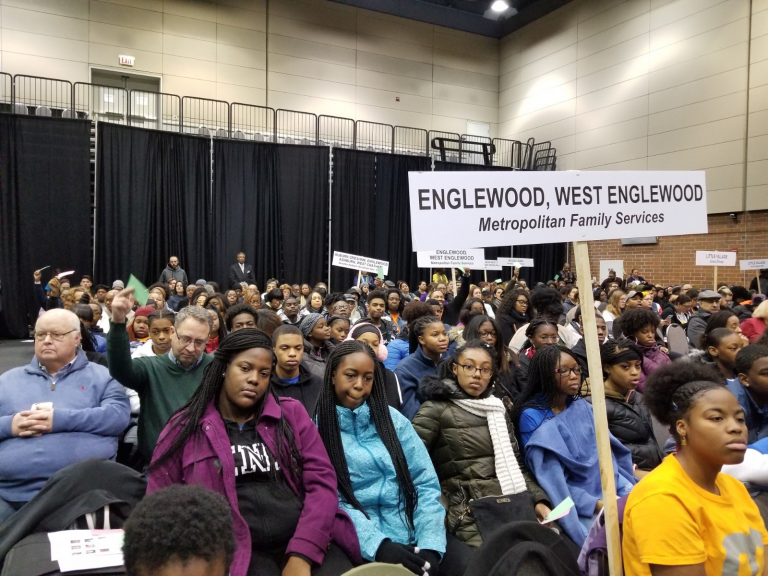The story of black Chicagoans leaving the city is largely mired in speculation and sometimes makes for grand political theater. Among the narratives offered by some have been: black residents leave because of violence; they are embarking on a reverse migration to the South; and they’re being pushed out.
A new report from the University of Illinois at Chicago busts some of those myths. Instead it finds a much more complicated story: black population trends in Chicago are strongly correlated to racial inequities in the city — and the pattern goes back decades.
Instead of a mass reverse migration to the south, the report found that when black movers leave Chicago, they’re more likely to stay in the region — with many relocating to surrounding counties in Illinois and northern Indiana. And despite more attention being paid to black population decline in recent years, the report notes that the trend is a long-standing one.
In 1980, decades of black population growth in Chicago stopped and reversed. By 2016, Chicago’s black population had decreased by 350,000 from its peak level of nearly 1.2 million in 1980.
“Taking the long view helps us to see the more recent patterns as part of a long and evolving history. From this vantage point, we find that black population trends in Chicago are associated with trends in levels of racial inequality, as indicated by racial disparities in unemployment and wages,” according to “Between the Great Migration and Growing Exodus: The Future of Black Chicago” by the Institute for Research on Race and Public Policy at UIC.
The report doesn’t definitively answer whether black residents are being forcibly pushed out of the city or moving elsewhere to pursue other opportunities. And the report doesn’t interview people who have left the city. It does provide a broad overview of black population growth in Chicago, stretching back a century, and an exhaustive breakdown of where the decline has occurred within the city over the past few decades. The report also notes the factors contributing to both the rise and fall of black population in the city.
Chicago’s black population grew steadily after 1920 during the Great Migration when African Americans left the South, fleeing racial violence or seeking better economic opportunities. While the city provided new jobs and housing, Jim Crow had its own version in the North. Contract buying, which bilked black families of $3 billion to $4 billion in wealth; restrictive covenants; disinvestment; and blockbusting awaited black families in Chicago.
While some of those practices became illegal, other segregationist policies took their place. From redlining to red light cameras, black Chicagoans on the South and West sides have dealt with inequality ever since they arrived.
That inequality has taken on many forms. According to the report, from 1990 through 2016, unemployment rates for black residents were around four times as high as they were for white residents. The wage gap between white and black residents has worsened each decade since 1980. And the city’s black communities have been disproportionately hit by deindustrialization and the growth of mass incarceration, which has contributed to black out-migration.
The report takes care to dig deep into neighborhoods. Black population declines are not spread equally and drivers of population vary. On the Near North Side and in Bronzeville, the clearance of public housing developments Cabrini Green, Robert Taylor Homes and Stateway Gardens caused black population decline. On the West Side, Austin lost more than 18,000 black residents between 1990 and 2016; the neighborhood had one of the highest foreclosure rates in the nation.
Among the places where African Americans are relocating, the report notes that Gary, Ind. may be more affordable for some black families. On average, when compared to whites leaving Cook County, blacks are relocating to areas with lower levels of educational attainment, higher unemployment and lower earnings.
The suburbanization that’s going on with black people is not the same as the suburbanization of white people in the 1950s and 1960s, said Amanda Lewis, a report author.
“It’s not a result of massive investment. It’s not because all kinds of new housing is being built, subsidized by the federal government. It’s not about the move of jobs,” Lewis said.
The report authors say the goal is for the information to encourage better policies that create a welcoming city for all. And the report declares that black Chicago is not dead.
Chicago’s black population remains second in the nation; only New York City has more black residents. From activists groups like Assata’s Daughters to legacy events like the Bud Billiken Parade to thriving black-owned businesses to black art creativity, the report notes that black Chicago still has assets.
Natalie Moore is a reporter on WBEZ’s Race, Class and Communities desk. You can follow her on Twitter at @natalieymoore.
9(MDM5MjE5NTg1MDE1Mjk1MTM5NjlkMzI1ZQ000))

